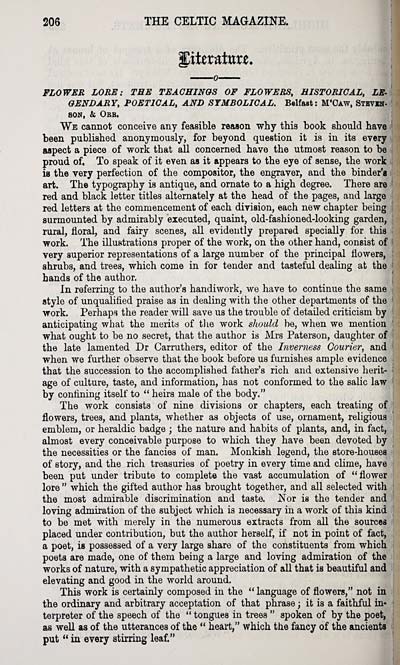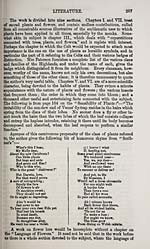Blair Collection > Celtic magazine > Volume 5
(216)
Download files
Complete book:
Individual page:
Thumbnail gallery: Grid view | List view

206 THE CELTIC MAGAZINE.
FLO WEB LORE: THE TEAGHINOS OF FLOWERS, HISTORICAL, LE-
GENDARY, POETICAL, AND SYMBOLICAL. Belfast: M'Oaw, Stbvxk- ' •.
BON, & Orb.
We cannot conceive any feasible reason why this book should have ' i
been published anonymously, for beyond question it is in its every , i
aspect a piece of work that all concerned have the utmost reason to be ,
proud of. To speak of it even as it appears to the eye of sense, the work , (
is the very perfection of the compositor, the engraver, and the binder's ■ !
art. The typography is antique, and ornate to a high degree. There are I -
red and black letter titles alternately at the head of the pages, and large > i
red letters at the commencement of each division, each new chapter being I i
surmounted by admirably executed, quaint, old-fashioned-looking garden, : {
rural, floral, and fairy scenes, all evidently prepared specially for this ; \
work. The illustrations proper of the work, on the other hand, consist of I :
very superior representations of a large number of the principal flowers, \ i
shrubs, and trees, which come in for tender and tasteful dealing at the i \
hands of the author. !
In referring to the author's handiwork, we have to continue the same j t
stylo of unqualified praise as in dealing with the other departments of the | (
work. Perhaps the reader will save us the trouble of detailed criticism by i I
anticipating what the merits of tlie work should be, when we mention ! ;
what ought to be no secret, that the author is Mrs Paterson, daughter of |
the late lamented Dr Carruthers, editor of the Inverness Courier, and i 3
when we further observe that the book before us fui'nishes ample evidence i >
that the succession to the accomplished father's rich and extensive herit- j {
age of culture, taste, and information, has not conformed to the salic law | j
by contLning itself to " heirs male of the body." i |
The work consists of nine divisions or chapters, each treating of
flowers, trees, and plants, whether as objects of use, ornament, religious ';
emblem, or heraldic badge ; the nature and habits of plants, and, in fact, j
almost every conceivable purpose to which they have been devoted by |
the necessities or the fancies of man. Monkish legend, the store-houses |
of story, and the rich treasuries of poetry in every time and clime, have ;
been put under tribute to complete the vast accumulation of "flower {
lore " which the gifted author has brought together, and all selected with I
the most admirable discrimination and taste. Nor is the tender and |
loving admiration of the subject which is necessary in a work of this kind
to be met with merely in the numerous extracts from aU the sources
placed under contribution, but the author herself, if not in point of fact,
a poet, is possessed of a very large share of the constituents from which
poets are made, one of them being a large and loving admiration of the
works of nature, with a sympathetic appreciation of all that is beautiful and
elevating and good in the world around.
This work is certainly composed in the " language of flowers," not in
the ordinary and arbitrary acceptation of that phrase ; it is a faithful in-
terpreter of the speech of the " tongues in trees " spoken of by the poet,
as well as of the utterances of the " heart," which the fancy of the ancients
put " in every stirring leaf."
I i
FLO WEB LORE: THE TEAGHINOS OF FLOWERS, HISTORICAL, LE-
GENDARY, POETICAL, AND SYMBOLICAL. Belfast: M'Oaw, Stbvxk- ' •.
BON, & Orb.
We cannot conceive any feasible reason why this book should have ' i
been published anonymously, for beyond question it is in its every , i
aspect a piece of work that all concerned have the utmost reason to be ,
proud of. To speak of it even as it appears to the eye of sense, the work , (
is the very perfection of the compositor, the engraver, and the binder's ■ !
art. The typography is antique, and ornate to a high degree. There are I -
red and black letter titles alternately at the head of the pages, and large > i
red letters at the commencement of each division, each new chapter being I i
surmounted by admirably executed, quaint, old-fashioned-looking garden, : {
rural, floral, and fairy scenes, all evidently prepared specially for this ; \
work. The illustrations proper of the work, on the other hand, consist of I :
very superior representations of a large number of the principal flowers, \ i
shrubs, and trees, which come in for tender and tasteful dealing at the i \
hands of the author. !
In referring to the author's handiwork, we have to continue the same j t
stylo of unqualified praise as in dealing with the other departments of the | (
work. Perhaps the reader will save us the trouble of detailed criticism by i I
anticipating what the merits of tlie work should be, when we mention ! ;
what ought to be no secret, that the author is Mrs Paterson, daughter of |
the late lamented Dr Carruthers, editor of the Inverness Courier, and i 3
when we further observe that the book before us fui'nishes ample evidence i >
that the succession to the accomplished father's rich and extensive herit- j {
age of culture, taste, and information, has not conformed to the salic law | j
by contLning itself to " heirs male of the body." i |
The work consists of nine divisions or chapters, each treating of
flowers, trees, and plants, whether as objects of use, ornament, religious ';
emblem, or heraldic badge ; the nature and habits of plants, and, in fact, j
almost every conceivable purpose to which they have been devoted by |
the necessities or the fancies of man. Monkish legend, the store-houses |
of story, and the rich treasuries of poetry in every time and clime, have ;
been put under tribute to complete the vast accumulation of "flower {
lore " which the gifted author has brought together, and all selected with I
the most admirable discrimination and taste. Nor is the tender and |
loving admiration of the subject which is necessary in a work of this kind
to be met with merely in the numerous extracts from aU the sources
placed under contribution, but the author herself, if not in point of fact,
a poet, is possessed of a very large share of the constituents from which
poets are made, one of them being a large and loving admiration of the
works of nature, with a sympathetic appreciation of all that is beautiful and
elevating and good in the world around.
This work is certainly composed in the " language of flowers," not in
the ordinary and arbitrary acceptation of that phrase ; it is a faithful in-
terpreter of the speech of the " tongues in trees " spoken of by the poet,
as well as of the utterances of the " heart," which the fancy of the ancients
put " in every stirring leaf."
I i
Set display mode to: Large image | Transcription
Images and transcriptions on this page, including medium image downloads, may be used under the Creative Commons Attribution 4.0 International Licence unless otherwise stated. ![]()
| Early Gaelic Book Collections > Blair Collection > Celtic magazine > Volume 5 > (216) |
|---|
| Permanent URL | https://digital.nls.uk/76451428 |
|---|
| Description | Volume V, 1880. |
|---|---|
| Shelfmark | Blair.6 |
| Attribution and copyright: |
|
| Description | A selection of books from a collection of more than 500 titles, mostly on religious and literary topics. Also includes some material dealing with other Celtic languages and societies. Collection created towards the end of the 19th century by Lady Evelyn Stewart Murray. |
|---|
| Description | Selected items from five 'Special and Named Printed Collections'. Includes books in Gaelic and other Celtic languages, works about the Gaels, their languages, literature, culture and history. |
|---|

